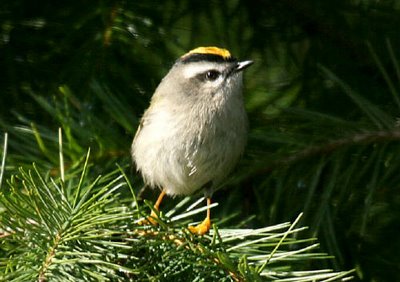Winter at Its Best...and more Kinglets
Winter Wilderness Birding with the Naturalist
Sun. Feb. 4 and Wed. Feb. 7
Since the New Year, I've been wanting, trying, wishing I could find a way to post an entry about three times a week. But the obstacle the past two weeks has been the arrival of real winter, and with it, the primordial urge to enjoy winter sports to the hilt before the season decides to duck out.

Everyone I know is finding ways to put their lives on hold so they can get in some backcountry skiing, cross-country skiing at Garnet Hill, and downhill skiing at Gore Mountain. Then there are the adventurous folks I know who have slipped crampons onto their boots for a hike up Crane Mountain (Yeah, it's icy on those rocks!). To be truthful, I can't keep track of all the day trips my friends are taking.
Today Sophie and I skiied all over a beautiful pond in the Siamese Ponds Wilderness. Funny, there was very little snow on the pond, but just enough to ski all over and into the marshy areas. We were the only ones out there; oh, I do love those Lewis & Clark moments.

Golden-Crowned Kinglets: I did promise more information on these tiny birds that spend all their time in the spruces and fir trees of the Adirondacks. One amazing fact about these birds is that they raise two broods each year. As soon as the first broods flies the coop, the mother immediately lays the second family of eggs. Meanwhile her mate continues to feed the first brood until they're ready to take over on their own.
Sun. Feb. 4 and Wed. Feb. 7
Since the New Year, I've been wanting, trying, wishing I could find a way to post an entry about three times a week. But the obstacle the past two weeks has been the arrival of real winter, and with it, the primordial urge to enjoy winter sports to the hilt before the season decides to duck out.

Everyone I know is finding ways to put their lives on hold so they can get in some backcountry skiing, cross-country skiing at Garnet Hill, and downhill skiing at Gore Mountain. Then there are the adventurous folks I know who have slipped crampons onto their boots for a hike up Crane Mountain (Yeah, it's icy on those rocks!). To be truthful, I can't keep track of all the day trips my friends are taking.
Today Sophie and I skiied all over a beautiful pond in the Siamese Ponds Wilderness. Funny, there was very little snow on the pond, but just enough to ski all over and into the marshy areas. We were the only ones out there; oh, I do love those Lewis & Clark moments.

Golden-Crowned Kinglets: I did promise more information on these tiny birds that spend all their time in the spruces and fir trees of the Adirondacks. One amazing fact about these birds is that they raise two broods each year. As soon as the first broods flies the coop, the mother immediately lays the second family of eggs. Meanwhile her mate continues to feed the first brood until they're ready to take over on their own.



